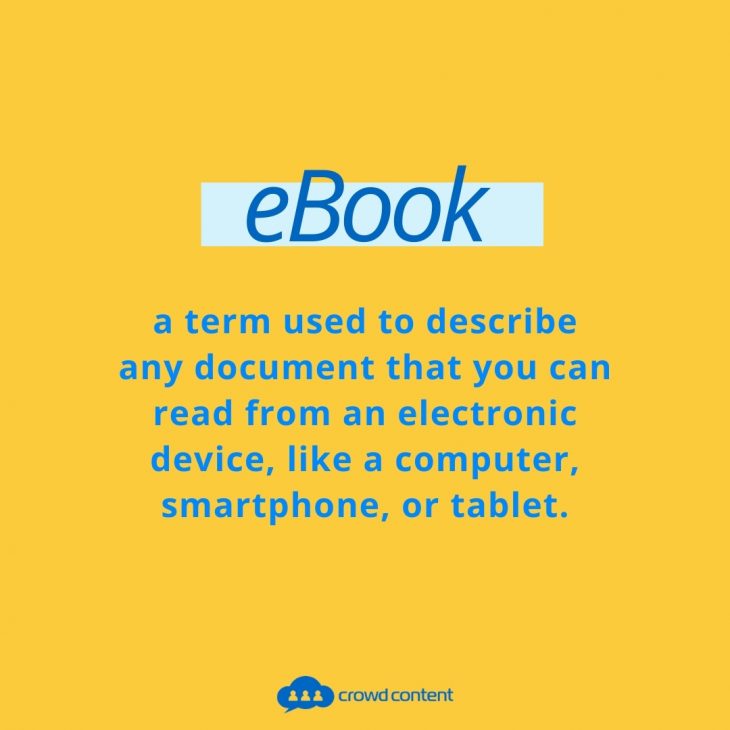The decision to create and publish an eBook can be driven by several factors that have to be weighed against the cost of creating an eBook.
Maybe you want to create something valuable to offer your existing audience. Maybe you want to use an eBook as a lead magnet that you promote via social media, paid promotions or SEO.
No matter why you want to create an eBook, there’s a question you have to ask yourself: will it generate a high enough return on your investment to make it worth the investment involved in creating it?
You can’t answer that question without having a full understanding of all the labor (and associated costs) that goes into conceptualizing, producing, and distributing an eBook.
ALSO – Check out our eBook writing services
Here’s a breakdown of all these elements, and how they affect total cost of creating an eBook.
First, What IS an eBook?
Technically, “eBook” is a term used to describe any document (typically a non-editable one) that you can read from an electronic device, like a computer, smartphone, or tablet. The more practical definition of an eBook is that it’s a long-form composition leveraged in a digital format in exchange for money, a lead submission, or something else that serves an objective of the creator.

Note – Most content marketers use eBooks as lead magnets to capture contact info from potential buyers. Most buyers are towards the middle of the funnel around the Interest stage of their journey.
Before we start breaking down the costs of creating an eBook, let’s make something clear. Yes, anyone can create an eBook — if you write two pages in a word document and export it into a PDF, technically, you’ve done it. But, what we’re talking about here is creating something of value — an eBook that delivers.
Typically, that means that your eBook that:
- Is at least 5,000 words
- Comprehensively covers the topic at hand
- Features an attractive, on-brand design
- Use hyperlinks in a table of contents for easy navigation
- Includes graphics, charts, illustrations and other visual cues

As we’ll describe below, this is a larger ask, and one that may involve costs that you aren’t thinking about right now.
Do it Yourself or Outsource?
Many digital marketers see eBooks as a worthwhile effort because they are a valuable piece of content that you can use to support multiple business goals. The main challenge often comes down to the time it takes to do it right.
You can spend hours working on the concept and the message of your eBook, and still not have anything that resembles the outline of a fully fleshed-out composition. And that doesn’t include researching, writing, editing, and designing your eBook which can take dozens of hours.
This is why many marketers choose to outsource their eBooks. They either outsource the smaller parts that they would struggle to handle on their own, or sometimes larger portions, serving to streamline the entire process. As we go step-by-step, we’ll talk about the cost of creating an eBook using outsourced talent.
Step 1: Developing the Concept
Before you start crafting your masterpiece, you have to build the framework for the entire exercise. What’s the topic? How will it be used to meet your goals? What audience does it speak to? Where are they at in the funnel when they read this?
This step doesn’t cost anything — there’s no charge for your own creativity.
Once you have a concept and loose outline, it’s time to start the creation of your eBook.
Step 2: Writing the Content
Step 2 comprises two parts: research and writing. They’re part of the same step because you’re probably going to want the person doing the research to also write the content that their research covers. And, you want that writing to be at a quality level that doesn’t need much editing after it’s written.
Alex Azoury, Founder and CEO of Home Grounds says the cost of creating an eBook depends on the writers you have access to.
“If you don’t have a writer on staff, then you’ll probably hire a freelance content writer or agency,” says Azoury. “Freelance writers differ in their experience, subject preferences, and costs. Think about whether you need a native English speaker or a competent writer whose English is at near-native level.”

If you’re hiring an “intermediate” writer, according to Azoury, they’ll typically charge between 5 and 20 cents per word. The average eBook is 2,500 to 5,000 words. That means that costs range between $125 to $250 on the lower end and $500 to $1000 on the high end.
When your topic is research-intensive, or you want to hire a writer with an expert knowledge of the subject, you’ll end up paying more. Budget as much 50 cents to 1 dollar per word, which will run you between $1250 to $2500 for a 2,500 word product.
Note – At Crowd Content, we always recommend clients use at least our 4-star writers which are priced at 12 cents per word. At that rate, you’ll need to provide a good amount of research and data to your writer. For more complex or research intensive projects we can set up a custom project.
A Cost Effective Alternative Method
If you want to save costs on content creation, you can use content you’ve already written and published in your eBook. If you’re writing a long form piece about a topic, chances are it’s a topic you’ve already explored before. During your planning steps, look for previously produced content that can be used to reduce the burden of researching, writing, and editing brand-new content.
Many marketers actually create a series of blog posts that could be considered episodic content, meaning that collectively they make up one larger story. Collecting these resources into an eBook is a very cost effective way of finding content for an eBook.
The reverse is also true – consider carving up sections of your completed eBooks into blog posts you publish (content repurposing). You can even include a link to the full eBook in the post which can generate a lot of leads.
Step 3 – Editing Your Content
The cost of editing, according to the Editorial Freelancers Association, varies based on the type of work you need. Basic copy editing is usually billed at around $30-$40 per hour, and if the copy needs a more intensive editor, that will increase to around $40-$60. If the average copy editor can get through an average of 5 manuscript pages per hour, a 2,500 word eBook (10 pages) will run you between $60 to $120 and a 5,000 word composition could cost an average of $240 at the high end.
Note – At crowd Content you can hire freelance editors for 3 cents per word. For more substantial editing requirements we can also set up a custom project.
Again, keep in mind that these numbers are for basic editing. If you want a copy editor to make multiple rounds of revisions and look deeply at changes that could improve the content, you may need to budget more.
If you decide you just need a proofread you might also be able to budget less, but we wouldn’t advise that.
Step 4: Designing the Assets
The design cost depends on the level of commitment you want to put into the aesthetics of your eBook. Do you want every page to be expertly laid out with full-color graphics, or will an eye-catching cover page suffice?
Alex Azoury again: “Your design includes your eBook cover, various elements within the book, and the final page. Someone will need to decide on the fonts and color used. All the headlines, paragraphs and text need to be formatted so that your book appears professionally produced.”
Azoury estimates that a complete design takes about five hours. If a freelance designer charges $30.00 per hour, that comes out to $150.00 for the project.
Keep in mind, that is a bare bone estimate and would likely result in a very basic looking eBook.
According to James Pollard, Founder of TheAdvisorCoach.com, “Some people will recommend going to a cheap site like Fiverr, but I’ve found that you get what you pay for. I suggest hiring a professional designer either directly or through a freelancing site.”

This level of premium design may cost you a lot more. Pollard estimates that for a fully produced, graphically rich cover design, it may cost as much as $500 for a final product that makes your eBook stand out.
That’s just for the basics, though. If you want to take time to create graphics, tables, charts and other visual elements, that will require more design time. An eBook with robust visuals can cost significantly more and may even creep into the thousands.
Whatever level of design quality and depth you choose, you’ll want to ensure the final package follows your brand guidelines and is appealing to readers.
Do It Yourself?
This all assumes that you opt to have a designer create your eBook. While usually that’s quicker and can produce a better result, there are a number of tools that can help you create your own eBook design for free.
- Microsoft Word – there are great templates available to pop your content into. While it can be tricky at times, it does let you add important elements like table of contents, cover pages, graphics and charts fairly easily.
- Online tools – Canva, LucidPress and FlipMaker all offer easy to use tools to create visually appealing eBooks. While there can be a small cost to using these tools, they might be a good fit for you.
Keep in mind that you should have a good eye for design if you go the DIY route.
Step 5: Repurposing and Distributing Your eBook
The most common eBook format is the PDF. And, that may be all you need to do.
But, you might also choose to put it in different formats and distribute it additional channels to increase its reach. Here are a few ideas:
- Create an audiobook version and make it available on services that offer listening like Spotify, iTunes, Google Play, Scribd, and others.
- Format it for Amazon Kindle Direct Publishing (KDP) and make it available on Amazon. You can make it available for free here, but many published authors earn significant revenue by charging for their eBooks
- Format your eBook in the ePub format for wider accessibility. This is the standard format used by eBook readers such as Kindle, Kobo, iBook, etc. There are many free and paid tools that can help you do this. This will also allow you to sell your eBook on marketplaces like Google Play and iBook.
- Break it up into several blog posts and post it on your blog
These are all relatively low cost ways to get your content to more of your audience, and you can even generate sales if you choose.
Step 6: Calculating Your Final Cost of Creating an Ebook and ROI
So, what’s the final cost of creating an eBook? As mentioned, the total investment depends on what you have available to as well as the level of depth and quality you’re aiming for.
A good ballpark for an average eBook would be around $3,000 dollars if you hire freelancers for everything. But, if you have access to some resources needed like existing content, design support, editing support, etc, the total cost can be a lot lower. Similarly, if you need an exceptional level of quality, tons of research, and need to hire an expert to write it, you could be looking at significantly more.
The amount you actually budget creating your finished product should depend on what you expect to gain from it when you leverage it to your selected market. According to James Pollard, “I tie it directly to a revenue metric in my business because I view it as an investment. I have no problem spending $3,000 to create an eBook that will generate $30,000 in sales over the next year.”
To understand and track the ROI of your eBook, the best way is to determine what the value of each lead who downloads your eBook is. To do this you can work backwards through your funnel. Here’s an example:
- Each new paying customer has a lifetime value of $100
- Of leads who download the eBook, 10% become paying customers
- Each eBook lead is therefore worth $10
- Since we spent $3,000 to produce this eBook, we need 300 eBook downloads for it to break even
This is just an example to illustrate this calculation. If you can track your ROI with actual numbers, you’ll be way better off.
Wrapping It Up
Quality eBooks can have a hugely positive ROI when used as lead magnets to support your other marketing efforts. Since the content they contain is so extensive and valuable, your audience is much more likely to offer their contact information in exchange for them. And, that’s not even counting other benefits such as increasing your perceived authority or boosting SEO.
But, they can be a big investment.
One way you can reduce the cost of creating an eBook and maximize ROI is by working with a reliable source of eBook writers. Crowd Content can help you find cost effective solutions for eBook creation and any other content needs, no matter how specialized or extensive.
Be sure to reach out if you could use a hand with your next eBook writing project.




